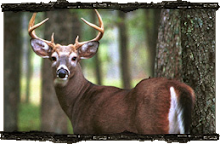
I imagine you're asking what a "browsing enclosure" is. No, its not to keep the deer in--its to keep the deer and other critters out. The project is looking for some ambitious outdoorsman/woman to make 8 of these things.
"Why?" you ask. Afterall, we want critters to come and eat at the logging sites. Well, these little enclosureswill tell us if any animals are eating at these plots. We will look at the contrast of plant growth inside the closure, where they can't touch it. This will help us to moniter whether we are attracting critters to our food plot.
Enclosed is a picture and instructions on how to make them. The club will gladly reimburse you for materials.
CONSTRUCTING A BROWSE EXCLOSURE
• Select Hoot-high welded wire fencing with 2x4-inch panels.
• Wearing gloves and using wire shears, cut the fence into lO-foot long sections. Each 10-foot long
section will form one browse exdosure.
When cutting through the horizontal
wires, make the cut close to
the next vertical wire, leaving tag
ends of horizontal wires projecting.
• Rollthe section until the ends connect
to form a cylinder. Bend the tag-end wires
of one end around the vertical end wire of
the opposite end, forming loops that attach
the ends of the rolled cage together.
• Drive sturdy stakes of rebar or wood
into the ground on opposite sides of the
cage and secure the cage to the stakes with
wire ties.Or,"weave"the stakes through at
least three panels near the bottom of the
cage by bending the panel wires slightly,
then drive the stake into the ground. The
cage should be secure enough to withstand
wind as well as animals pushing
against it.
to form a cylinder. Bend the tag-end wires
of one end around the vertical end wire of
the opposite end, forming loops that attach
the ends of the rolled cage together.
• Drive sturdy stakes of rebar or wood
into the ground on opposite sides of the
cage and secure the cage to the stakes with
wire ties.Or,"weave"the stakes through at
least three panels near the bottom of the
cage by bending the panel wires slightly,
then drive the stake into the ground. The
cage should be secure enough to withstand
wind as well as animals pushing
against it.
• Select Hoot-high welded wire fencing with 2x4-inch panels.
• Wearing gloves and using wire shears, cut the fence into lO-foot long sections. Each 10-foot long
section will form one browse exdosure.
When cutting through the horizontal
wires, make the cut close to
the next vertical wire, leaving tag
ends of horizontal wires projecting.
• Rollthe section until the ends connect
to form a cylinder. Bend the tag-end wires
of one end around the vertical end wire of
the opposite end, forming loops that attach
the ends of the rolled cage together.
• Drive sturdy stakes of rebar or wood
into the ground on opposite sides of the
cage and secure the cage to the stakes with
wire ties.Or,"weave"the stakes through at
least three panels near the bottom of the
cage by bending the panel wires slightly,
then drive the stake into the ground. The
cage should be secure enough to withstand
wind as well as animals pushing
against it.
to form a cylinder. Bend the tag-end wires
of one end around the vertical end wire of
the opposite end, forming loops that attach
the ends of the rolled cage together.
• Drive sturdy stakes of rebar or wood
into the ground on opposite sides of the
cage and secure the cage to the stakes with
wire ties.Or,"weave"the stakes through at
least three panels near the bottom of the
cage by bending the panel wires slightly,
then drive the stake into the ground. The
cage should be secure enough to withstand
wind as well as animals pushing
against it.
We will need 8 of these by the end of July.
Contract Marcia Baker at 841-0496.
Reference: Kammermeyer, Miller, and Thomas, Quality Food Plots, A Publication of the Quality Deer Management Association. p. 139 This is a great book for anyone who wants to start doing their own personal plots. You can order it on the QDMA website.

No comments:
Post a Comment